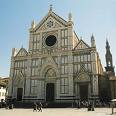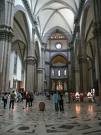Duomo of Florence
 The unfinished facade of the Duomo, originally built by Arnolfo di Cambio, was torn down in 1587. From then on, for almost three centuries, there was a continuous flow of projects and competitions for the new facade of the Cathedral until finally in 1871 the design presented by the architect Emilio de Fabris was approved (work ended in 1887).
The unfinished facade of the Duomo, originally built by Arnolfo di Cambio, was torn down in 1587. From then on, for almost three centuries, there was a continuous flow of projects and competitions for the new facade of the Cathedral until finally in 1871 the design presented by the architect Emilio de Fabris was approved (work ended in 1887).
The facade betrays the historical point of view which ruled the taste of the times and employed the same types of marble previously used in the rest of the building - Carrara white, Prato green and Maremma pink. Above the three portals with Stories of Mary are three lunettes with, from left to right, Charity, the Madonna with the Patron Saints of the City, and Faith; the pediment over the centrai portai has a Madonna in Clory.
The statues of the Apostles and of Mary are set in the frieze that runs between the rose windows at the sides and the one in the center. Above, after a series of busts of artists, is the pediment with the low rei ief of Cod the Father.
Inside the Duomo of Florence
 The interior of the Duomo, according to the will of the Italian Gothic architecture, has a strong feeling of vertical and horizontal space, being the fourth largest church in the world. The internal dimensions of the Duomo are 153 m long, 38 m wide across the nave and aisles, and 90 m at the transept.
The interior of the Duomo, according to the will of the Italian Gothic architecture, has a strong feeling of vertical and horizontal space, being the fourth largest church in the world. The internal dimensions of the Duomo are 153 m long, 38 m wide across the nave and aisles, and 90 m at the transept.
In the nave and aisles, piers with pilaster strips support large moderately pointed arches and ribbed Gothic vaulting. A gallery on corbels runs along on high. At the back is the high altar (by Baccio Bandinelli) surrounded by three apses or tribunes, each subdivided into five rooms. The polychrome marble pavement (1526) is by Baccio and Giuliano d'Agnolo, Francesco da Sangallo and others.
The two equestrian monuments (frescoes transferred from the wall) of john Hawkwood (Giovanni Acuto) and Niccolò da Tolentino are on the wall of the left aisle. The former, of 1436, is by Paolo Uccello; the latter, of 1456, by Andrea del Castagno (observe the diversity in the modelling of the figures of these two mercenary captains: severity as opposed to vitality). To be noted among the many other works are the Tomb or Antonio d'Orso by Tino di Camaino (1321); the lunette with the Crowned Madonna by Gaddo Gaddi; and in the left aisle the tabernacle with lushes by Ciuffagni, Donatello and Nanni di Bartolo; the Bust or Squarcialupi by da Maiano, the panels with Saints Cosmas and Damian by Bicci di Lorenzo.